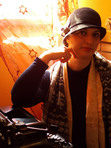Call and Response (AtoZ Challenge 2016 – Jazz Age Jazz)
JAZZ AGE JAZZ - Call and Response #AtoZChallenge #jazz as a strong communal creation
Click To Tweet
Call-and-response is one of the most defining characteristics of jazz, one that comes stright out of the musicâs African origin.
In whe work songs there would be a leader calling a line and a group responding to that line. So in jazz (especially early jazz) there would be an instrument proposing a melody and the other instruments would respond to it, would improvise around it.
But call-and-response went beyond the bandstand. The same way musicians influenced and prompted each other, so would the public. The audienceâs reaction was vital to the performance because musicians would improvise on the base of audienceâs input.
This was particularly true when people danced to jazz music. Dancers would react to the music, improvising new steps, and musicians would catch the new steps, their rhythm, and improvise new music on that.
Jazz was a very strong communal creation any way you looked at it, still how tcall-and-response was understood and practiced was always one of the things that most distinguished black from white jazz in America.
 St. Louis Cotton Club Band Jazz Postcard Photo: Block Bros Studio, 1925 Missouri
St. Louis Cotton Club Band Jazz Postcard Photo: Block Bros Studio, 1925 MissouriWhite jazz was not only more mellow compared to the hot black jazz, it was also consumed in a more âEuropeanâ way. There would always be an invisible line between musicians and audience that was very seldom crossed.
In black establishments, the public would participate in the performance and would actually influenced it. In addition to communal creation of music between musicians and dancers, listeners would often comment the music and would protest loudly if they didnât like it, or cheer hotly when they did like it. Throwing objects to the band to signal the audienceâs displeasure wasnât unheard of.
White establishments tried to adapt a more direct enjoyment of jazz by trying to blur the barrier between audience and performers, for example by bringing the show on the dance floor, on the same level as the audience. Dancers would often move among the tables, the audience was encouraged to show their appreciation or displeasure by clapping their hands or banging cutlery on the tables. But it always remained, at heart, a very different kind of involvement than the African American version.
—————————————————————————————————————————————
RESOURCES
Ogren, Kathy J., The Jazz Revolution. Twenties America and the Meaning of Jazz. Oxford University Press, New York, 1989
Jazz in America –
Smashwords | Barnes&Nobles | Kobo | iBookStore
And many other stores
The post Call and Response (AtoZ Challenge 2016 – Jazz Age Jazz) appeared first on The Old Shelter.






